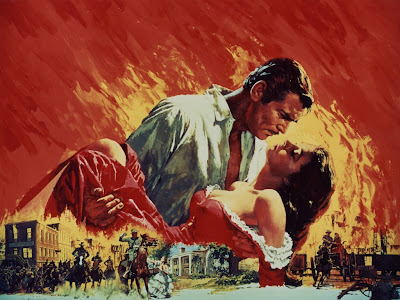One of the coolest things Raleigh, North Carolina offers is a free state history museum, which permanently houses an entire floor dedicated to the state's history as well as several rotating exhibitions. For the past fews months, and extended by popular demand, the museum has been home to an exhibit of memorabilia, costumes, and artifacts from the American classic Gone with the Wind.
As a kid, I coveted a copy of the film my grandmother had taped off cable in 1987, intact with the archaic commercials and fuzzy sound. I didn’t care that it took six hours to watch an already lengthy movie. I swooned over the period costumes, the tangled romances, and the devastatingly handsome Clark Gable.
Alex's note: I grew up having only watched the movie once, in numerous segments, in my 7th grade English class. It wasn't until this January, after buying the movie on DVD for Alexa, that I had a chance to watch it all in one sitting. I found it to be much better than I had remembered. From a cinephile's point of view, it had some groundbreaking cinematography and set design. To use actual outdoor settings rather than studio lots or, even worse, indoor sets to mimic the outdoors, and to do this in full glorious Technicolor, was nothing less than impressive. And I won't lie, that Clark Gable is devastatingly handsome.
 |
| Original painted storyboard from the "Atlanta is burning" scene. |
The exhibit was a behind the scenes look into a film I’ve loved since childhood. It included original storyboards, photographs, and notes from cast members. Hattie McDaniel, who played Mammy and subsequently became the first African-American to win an Academy Award for the role, sent thank-you notes to nearly every member of the production team, several of which appear in the exhibit. Because segregation was an ugly reality, even in Los Angeles in the late 1930s, McDaniel and the other African-American actors used separate dressing rooms and waited in separate areas between takes. It wasn’t until Clark Gable stepped in and demanded equal treatment for the black actors, threatening to walk off the set, that on-set segregation was done away with.
The film, even in its time, provoked mixed reactions for its portrayal of African-Americans. Butterfly McQueen, who was a dancer before starring as Prissy in Gone with the Wind, famously stated that she struggled with the role as it was difficult for her to play such an unintelligent character.
Alex's note: I've found a lot of the criticism for the film's portrayal of race to be overly PC. The fact is that there were domestics like Mammy and Prissy and they were slaves and they did speak in a certain vernacular. To dismiss historical accuracy as racism is misguided at best, but to make these claims without knowing the back-story of its actors demanding an integrated set is just foolish.
Other artifacts of note were original sheet music from the Gone with the Wind score, a copy of the novel owned by Butterfly McQueen, and the Oscar statue won by Vivien Leigh for Best Actress. Video footage of the 36 screen tests shot in the search for Scarlett O’Hara played on a screen, including one with Paulette Goddard who appeared in Modern Times and The Great Dictator with Charlie Chaplin.
Alex's note: As a Chaplin fan, I admire Paulette Goddard quite a lot. She is probably my favorite of Chaplin's leading ladies in his feature films, but her personality and affect would have made her a terrible choice for Miss Scarlett. If there had been a scene where we met Scarlett's street-wise cousin from the North, then Goddard would have been a shoe-in!
 |
| Butterfly McQueen's copy of the novel. |
 |
| Sheet music to the original score. |
 |
| Bonnie's equestrian outfit. |
 |
| Scarlett's "Shantytown" dress. |
 |
| Scarlett's hat for the Twelve Oaks barbecue. |





No comments:
Post a Comment